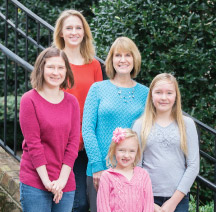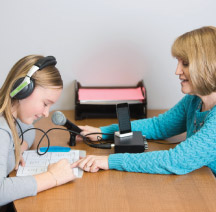A Voice for Children, Optimal Performance for Adults



by Patty Jo Sawvel ~
When Kim Fletcher Fulp was four years old, her Aunt Becky and Uncle Dwane gave her the perfect present—a new baby cousin named Gina. Because the girls were neighbors, they soon became dear friends. So it troubled Kim when she realized that Gina’s hidden cleft palate was preventing her from asking for what she wanted.
“I saw how frustrating this was for her and from the beginning I had a deep desire to help,” Kim said fondly.
At a very young age, Kim poured her heart into teaching Gina words. Using picture books, Kim pointed at a picture, said the word, and then Gina repeated it. They would both giggle, high-five, or act silly when Gina labeled the picture correctly. Although Gina was learning dozens of words, she could not always say them clearly.
“She had trouble forming many consonants. So ‘baby’ sounded like ‘aye-ee,’ ‘cat’ sounded like ‘at,’ and ‘dog’ sounded like ‘dah,’” Kim explained.
At six years of age, Kim was allowed to accompany two-year-old Gina to visit with her speech pathologist (formerly known as a speech therapist). Kim watched with interest as the professional placed her thumb and forefinger on Gina’s lips and out popped a perfect “m” sound!
“Looking back, I realize that this was a defining moment for my future. I wanted to help children learn to talk. I have never wanted to do anything else,” Kim shared joyfully.
So Kim added that technique—and dozens of others that she would pick during her many observations of Gina’s therapy—and began to use it in her “practice” as a child. Also, knowing what she wanted to do with her life at an early age helped Kim become focused at school. During her high school years, she became a favorite babysitter for her teachers at Parkland High School and many community business leaders. This additional experience with children formed another huge building block in Kim’s future career.
Next, she acquired both her Bachelor’s Degree and Master’s Degree in Communication Disorders at Appalachian State University. Then, she worked in private practice directly with children for a few years, followed by work in a second private practice where she gained supervisory and business experience.
“Finally, in 1996, I had everything in place to live my dream. I had married my husband, Gene —who now takes care of my computer and technology needs—we had two little girls (Erin and Kaitlyn), and leaning on the foundation of my faith and my trust in God, I started my private practice. Initially, I went into daycares, child development centers, and private homes. In 2000, I opened the offices of Fulp Therapy Services, Inc. in Winston-Salem. In 2008, I moved my practice to Kernersville,” Kim explained.
As anticipated, Kim Fulp’s career has brought her much joy and given joy to others. She has been especially drawn to helping children with autism or other special needs. Often these children’s language skills come in late and even then, they have trouble using language to get what they want.
Cindy Watson* brought her son, Wade, to Kim when he was three years old. He was very aggressive, had a lot of behavioral issues, and had very little functional language.
“From the beginning I could see that Kim was a natural in working with my son,” said Cindy appreciatively. “Kim was patient and she had him speaking clearly and quickly in a short period of time. Now he is 13 and we cannot get him to stop,” she added with a laugh.
Ned Bailey*—who drives 45 minutes one-way to get his daughter Ella to see Kim—was also impressed by the instant trust and therefore immediate results that Kim continues to have with her “little friends.”
“My daughter loves to go see Miss Kim. When we walk in the door, Ella takes Miss Kim’s hand and pushes me aside. It is just so clear that Miss Kim has a passion for the kids and they can sense it,” Ned said in amazement.
To help Ella succeed, Kim first taught this non-verbal child sign language—converting frustration to personal power. Then, Kim transitioned to spoken language. Step by step this child is using language as a tool to connect with her family and the outside world.
“The key,” shared Kim, “is to find out what motivates a child and to help them achieve many small successes.”
What motivates children can be quite amazing. According to Kim, some kids like to spin in her chairs, play with toys, or eat tiny pieces of Skittles.
Kim, who also works in the schools as a speech-language pathologist, has had good success treating stuttering. She recalls one 12-year-old girl who had difficulty speaking fluently when presenting in class. In her sessions, Kim gave this middle schooler the tools to deal with her feelings of embarrassment and new skills in breath control.
“She did not need any outside motivation,” Kim said consolingly, “and in six months she had overcome her stuttering. Of course, every child is different, but if a child has a delay, a deficit, or a disorder, it can sometimes be addressed in a relatively short period of time.”
Over the past 22 years, Kim has continued to add to her expertise as a speech-language pathologist by attending classes and conferences. She has constantly searched for ways to bring new ideas, techniques, and technology to her clients to empower them with the gift of communication. When Kim witnessed the power of Integrated Listening Systems (iLs)—which combines music, motors skills, and language—she began offering this program to her “little friends” (ages Pre-K to 13) with attention deficit disorder (ADD), learning disabilities/differences, and auditory processing challenges with excellent results. “Not only are my clients making huge improvements in their communication skills, but they are more focused and able to attend to tasks better,” reported Kim.
However, Kim Fulp is also excited about a new program that helps adults (age 14 and up) to achieve optimal performance. In a nutshell—this Integrated Listening/Learning System retrains the brain so that learning, communication, and movement cooperate for the best possible outcome. Research indicates that people who complete the 24-session program report a higher level of creativity, motivation, inspiration, and information processing while experiencing a decreased level of fatigue, stress, and poor sleep.
“This is a great program for athletes, executives, artists—anyone wanting to be their best—because it trains all of your senses at once, which gives you quick and integrated results,” Kim said.
When Kim went through the program personally, the first thing she noticed is that her mind was more alert, her focus was enhanced, and her sleep was more restful.
“Often, people in the program will discover emotional blocks that have been causing them to ‘hold back.’ Once these are released, a new surge of creativity and productivity is unleashed. It is an amazing and quick process,” Kim said confidently.
All in all, Speech Pathologist Kim Fulp finds her joy in helping people of all ages to be their best. For many of her “little friends,” she helps them find their voice and develop the powerful tool of language. Now, for her “adult friends”—those ready to move beyond language—Kim has brought the holistic Integrated Learning Systems to Kernersville so that everyone has the opportunity to achieve Optimal Performance.
“There is so much good that we all can do when we learn to connect with all the levels of our internal selves. Then we are in our best position to connect externally with others around us. It is this spirit of ‘connectedness’ and ‘excellence’ that initially attracted me to Kernersville. It has proved to be a blessed move because my faith, my family, and my practice have all flourished,” Kim said graciously.
*names have been changed in this story to protect family privacy
Award-winning author/writer Patty Jo Sawvel, lives in Kernersville and can be contacted at pjsawvel@gmail.com.
More About Us:
Fulp Therapy Services, Inc.
Kim Fulp – Speech-Language Pathologist, 22 years
Traditional speech-language therapy, when paired with iLs programs, can produce dramatic results for communication disorders associated with the following diagnoses:
- Asperger’s Syndrome
- ADD/ADHD
- Autism Spectrum Disorder
- Childhood Apraxia of Speech
- Developmental Delays
- Down’s Syndrome
- Hearing Impairment
- Traumatic Brain Injury
Programs for Adults (ages 14 and up) include:
- Optimal Performance—a 24-week integrated learning system that enhances creativity, productivity, inspiration, and motivation—helping you to be your best. This is sometimes called a “gym for the brain” or “crossfit” for the mind.
900 Old Winston Road, Suite 106
Kernersville, NC 27284
336-993-5769
www.fulptherapyservices.com
Did you know?
- When a child is embarrassed by his/her speech or begins avoiding activities it is time to seek the help of a professional speech pathologist.
- Preschool stuttering or dysfluency is common. Parents can model “relaxed” speaking and talk openly about how the child feels about his/her speech. If dysfluency persists, consult a speech pathologist.
- Retraining the brain through a holistic integrated system can enhance creativity, coordination, and productivity for both children and adults.

